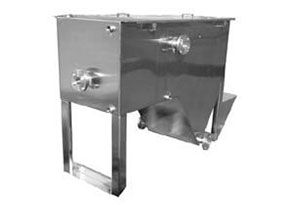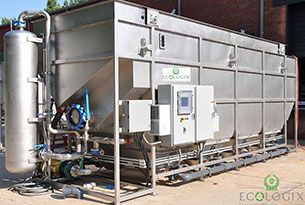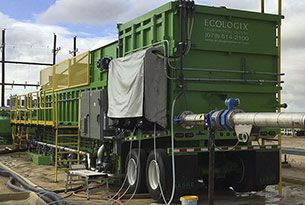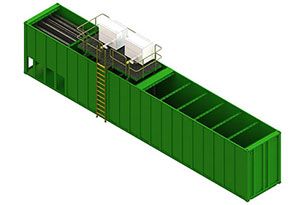Ecologix Wastewater Treatment FAQs
- What types of wastewater treatment systems does Ecologix offer?We provide a comprehensive range of wastewater treatment solutions tailored to your needs, including oil-water separators, dissolved air flotation (DAF) systems, moving bed biofilm reactors (MBBR), membrane bioreactors (MBR), integrated biological reactors (IBR), Bio-Clear packaged treatment systems, lamella clarifiers, chemical reaction tanks, floctubes, multi-plate screw presses for dewatering, and advanced options like reverse osmosis and ultrafiltration. If your specific challenge requires a unique solution, our team will design, build, install, and provide training to ensure smooth operation and optimal performance.
- Which industries do you serve with your systems?We serve a wide variety of industries, from automotive and food & beverage to oil & gas, dairy, meat processing, mining, municipal wastewater, and fracking/produced water treatment. No matter your sector, we're here to help. Simply reach out, and we'll work with you to address your wastewater challenges effectively.
- Are your systems customizable for specific wastewater challenges?Absolutely. Almost every system we design is customized to fit the unique conditions of your site, including flow rates, influent characteristics, and effluent requirements. Very few applications fit a "one-size-fits-all" approach, so we collaborate closely with you to create a solution that meets your exact needs.
- Does Ecologix offer installation services?Yes. We do it when the client needs us to. This includes unloading equipment, on-site assembly, plumbing connections to and from the system, electrical wiring, burial (if needed), grading, concrete work, backfill, commissioning, and startup. Our goal is to get your system up and running efficiently with minimal disruption.
- How do your solutions ensure compliance with environmental regulations?Our design process starts with a thorough analysis of your influent constituents, their concentrations, and the required effluent limits. We provide detailed calculations to demonstrate how our system will meet or exceed regulations, and many of our solutions come with an effluent performance guarantee upon installation. This helps you achieve compliance confidently.
- What maintenance is required for Ecologix equipment?Maintenance varies by system type, but we supply a customized operation and maintenance manual with every installation to guide you. Generally, it involves regular inspections, cleaning, and servicing of components like pumps, motors, blowers, and control systems.
- What is the expected lifespan of your wastewater treatment systems?Lifespan depends on environmental factors, but in typical conditions, our systems can last 15 to 20 years or more with proper care. Harsh environments (e.g., high salinity, extreme pH) may reduce this to 8 to 12 years, while indoor installations and regular maintenance can extend it. Components like blowers and pumps need rebuilding every 5 years or so, depending on usage.
- Do you provide references?Yes, with over 20 years of experience in designing and fabricating water and wastewater systems, we have numerous satisfied clients across industries. We're glad to share relevant references upon request to help you feel confident in our expertise.
- What is the best way to get a quote?The easiest way is to visit our Contact page or fill out one of our specific forms (or the general one if you're unsure). At minimum, provide your flow rate, daily operating hours, a copy of your permit, and a water quality report detailing constituents and their levels. This allows us to give you an accurate, tailored quote quickly.
- The state is requiring a pretreatment system plan before issuing a permit. Can you help with this?Yes, we specialize in helping clients navigate permitting requirements. Our team can develop a detailed pretreatment plan, including system designs, calculations, and documentation to satisfy regulatory needs. Contact us with your specifics, and we'll guide you through the process.
- What is pretreatment?Pretreatment involves removing large debris such as rags, sticks, grit, and floating grease to prevent damage or operational issues in downstream equipment like pumps and treatment units. Common tools include screens, grit chambers, and oil-water separators. This step is crucial for protecting the overall system and improving efficiency.
- What is primary treatment?Primary treatment focuses on removing settleable solids and floating materials. It typically includes an equalization tank to stabilize flow, chemical reaction tanks or floctubes for coagulation and flocculation, and a DAF or clarifier for separation. This reduces total suspended solids (TSS) and prepares wastewater for further treatment.
- What is secondary treatment?Secondary treatment primarily targets biological oxygen demand (BOD) by removing biodegradable organic matter in solution or suspension. It can also address nutrients like nitrogen and phosphorus. Systems like MBBR, MBR, or activated sludge are used here, often including disinfection to meet standards for safe discharge or reuse.
- What is polishing or tertiary treatment?Tertiary or polishing treatment removes remaining fine solids (typically 5 to 50 mg/L) and other contaminants after primary and secondary stages. Options include bag filters, micro screens, granular activated carbon (GAC), activated glass media, ion exchange resins, and ultrafiltration. This ensures high-quality effluent for sensitive applications or strict regulations.
- I've been fined for excessive BOD. Which systems should I look at to lower my BOD?Reducing BOD depends on your site's specifics, such as available space, indoor/outdoor setup, and existing infrastructure. We recommend exploring our IBR, Bio-Clear, MBBR, and MBR systems, which excel in biological treatment for BOD removal. Start by reviewing those pages on our site, then contact us for a free consultation to identify the best fit.
- Do DAF and clarifier systems do the same thing? Since clarifiers are less expensive, why would anyone choose a DAF?While both separate solids from liquids, they differ in application. Clarifiers rely on gravity for heavier solids and are more budget-friendly for those scenarios. DAF systems use air bubbles to float lighter particles like oils and fine solids, making them faster and more efficient for emulsified or low-density wastes. Choose DAF for better performance in challenging wastewaters, even if it costs more upfront. It often saves on operations long-term.
- I'm paying too much to haul off my system's wet sludge. What are the dewatering options, and when is the ROI under two years?We offer dewatering solutions like multi-plate screw presses, belt presses, and centrifuges to reduce sludge volume and hauling costs. As a rule of thumb, onsite dewatering becomes cost-effective with monthly hauling fees around $20,000 or more, often achieving ROI in under two years through reduced disposal expenses. Let's discuss your sludge characteristics for a customized recommendation.
- What are the key design parameters for sizing a DAF system for wastewater with high suspended solids and variable oil content?Key parameters include flow rate, total suspended solids (TSS) loading, oil and grease concentrations, and required surface loading rate (typically 1 to 5 gpm/ft²). Check our DAF page for a table of models with flow rates and surface areas. We calculate minimum surface area based on your TSS and flow to ensure efficiency. Share your data for precise sizing assistance.
- How can MBBR technology be integrated with existing activated sludge systems to enhance BOD and COD removal in high-load industries like dairy?Ecologix's MBBR can be retrofitted into existing activated sludge systems to boost capacity without major expansions. By adding biofilm media to aeration tanks, it increases biomass concentration and resilience to load fluctuations, achieving up to 10 times higher BOD/COD removal rates. For dairy wastewater with high organic loads from milk processing, this hybrid approach handles pH swings and sugary effluents effectively, ensuring consistent compliance. Contact us for integration details.
- What treatability studies or pilot testing options do you recommend for assessing coagulation and flocculation efficiency in metals-laden mining wastewater?We suggest beginning with bench-scale jar tests to screen coagulants, dosages, and pH adjustments for optimal metals precipitation. This helps refine designs for mining wastewater. Reach out to schedule a study tailored to your site.
- How do your lamella clarifiers perform in terms of settling rates and footprint reduction for sludge-heavy streams in meat processing?Our lamella clarifiers provide rapid settling rates (up to 10 times faster than conventional clarifiers, often 0.5 to 2 m/h) by using inclined plates to increase effective surface area. They reduce footprint by 80 to 90%, making them perfect for space-constrained meat processing facilities handling high-sludge loads from carcass washing. This leads to clearer effluent and easier sludge management.
- What are the operational considerations for using multi-plate screw presses in dewatering low-concentration sludge from biological treatment processes?Key considerations include selecting appropriate polymers for flocculation to improve dewatering, adjusting screw speed and torque for optimal pressure, monitoring feed consistency to avoid overloads, and scheduling regular cleaning to prevent buildup. Our presses are resistant to clogging from low-concentration sludge, use low energy, and operate automatically. Ideal for biological processes. We provide training to ensure smooth operation.
- Can your chemical reaction tanks be customized for advanced oxidation processes to target emerging contaminants like pharmaceuticals in industrial effluent?Yes, our chemical reaction tanks offer flexibility for customization, including integration of advanced oxidation processes (AOPs) like UV/H2O2, ozone, or Fenton's reagent. This setup effectively degrades persistent contaminants such as pharmaceuticals by generating hydroxyl radicals. We'll design it to fit your flow rates and effluent goals for superior removal.
- Can you help us with ammonia, phosphorus, and hydrocarbons in produced water from fracking operations?Yes, we offer turn-key solutions for fracking produced water. For ammonia and phosphorus, biological treatments like MBBR or MBR promote nutrient removal through nitrification/denitrification and precipitation. Hydrocarbons are handled via DAF or oil-water separators for efficient separation. Our mobile systems allow on-site recycling. Share your water analysis for a customized plan.
- What are the pros and cons of using floctubes versus chemical reaction tanks for extending reaction times in high-flow chemical precipitation setups?Floctubes pros: Compact triple-pass design extends contact time efficiently in high-flow scenarios, promotes better coagulation/flocculation with minimal space, and reduces chemical usage. Cons: Less adaptable to process changes or variable flows.
Chemical reaction tanks pros: Highly customizable for volume, mixing intensity, and multi-stage reactions, ideal for complex chemistries. Cons: Larger footprint and potentially higher initial costs. We can help choose based on your setup.
- How can oil-water separators be optimized for recycling produced water in oil & gas fields with fluctuating salinity and naphtha content?Optimization involves using coalescing media to enhance separation of variable oils, incorporating adjustable skimmers and weirs for flow control, and adding chemical pre-treatments (e.g., demulsifiers) to handle salinity and naphtha fluctuations. Our separators efficiently remove hydrocarbons lighter than water, enabling reuse. Regular monitoring and modular designs ensure adaptability. Let's discuss your field conditions.
- What mass balance approaches do you use to model pollutant removal across integrated systems like DAF followed by MBBR for municipal-industrial hybrid wastewater?We use conservation of mass principles in mass balance modeling, calculating inlet/outlet flows and pollutant concentrations for each unit (e.g., 85 to 95% TSS removal in DAF, 70 to 90% BOD in MBBR). Tools like custom spreadsheets or software (e.g., BioWin) incorporate removal efficiencies, recycle streams, and kinetics to predict overall performance. This ensures accurate design for hybrid wastewaters. Contact us for a modeled proposal.
- What troubleshooting steps should be taken for inconsistent dosing in chemical feed systems during variable pH wastewater treatment?To resolve inconsistent dosing:
- Calibrate pumps and meters for accurate flow.
- Clean and verify pH sensors for reliability.
- Inspect lines for clogs or leaks.
- Use real-time monitoring to adjust doses dynamically.
- Check chemical stability and storage conditions.







